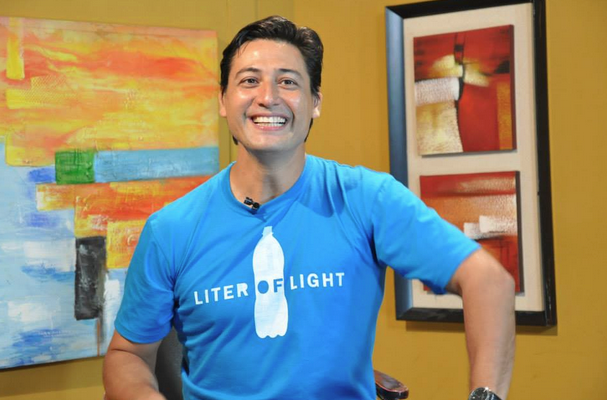
Photo via Padarth
Why we love Liter of Light:
Liter of Light is the latest project launched by the MyShelter Foundation, an organization dedicated to bringing low-cost, innovative green technology to rural communities with limited resources. Using a technique created by MIT students and Alfredo Moser, the organization brings to homes a simple plastic bottle that when filled with water and chlorine, and activated by sunlight (through the process of refraction) produces the same light as a 55-watt bulb.
So far, Liter of Light has operated primarily in the Philippines, bringing light to 28,000 homes and 70,000 people in Manila alone. The organization operates on a grassroots level, using volunteer power to spread the eco-friendly technology around the world. While projects are currently underway in India, Indonesia and Switzerland, the organization’s goal is to install bottle lights in 1 million homes worldwide by the end of 2015.
While their goal may seem lofty, the organization has some pretty big sponsors and partners including Pepsi, Reuters and the US Embassy of Manila to move things forward. Ultimately, their success hinges on volunteers around the world. Read on to learn more about the different levels of involvement and how you can help bring light to communities in need.
Photo via Liter of Light FaceBook
The mission:
MyShelter believes in the power of green technology, but also realizes that in most cases, it’s not accessible to those in struggling communities. Their mission is to create easily replicable technologies that can be built with the resources available in the communities they’re working in. By introducing low-cost sustainable building solutions, locals can learn how to assemble their own green technology.
The founder’s story:
Photo via Liter of Light FaceBook
The MyShelter Organization and consequent Liter of Light project was founded by social entrepreneur Iliac Diaz. After earning a Bachelor’s degree in Management Economics from the Ateneo de Manila University, Diaz furthered his education with a Masters Degree in Entrepreneurship from the Asian Institute of Management (AIM), a Masters in Political Administration from Harvard University and courses in Urban Studies and Planning at Boston’s MIT. With all of that under his belt, Diaz decided to dedicate his wealth of knowledge to community enrichment projects in his home country, the Philippines.
Named a “Young Global Leader of 2008” by the World Economic Forum in Geneva, Switzerland, Diaz is now running a number of organizations including Liter of Light, the CentroMigrante Project– “a build-for-stay system [in which] the tenants will be able to stay in the compound in exchange for their labor in constructing parts of the project,” and the Pier One Seafarer’s Dormitory–”a lodging place for Filipino seafarers located in a 2,500-square meter lot at Corte Real and Solana Streets in Intramuros, Manila.”
Diaz travels around the world sharing how green technology can change lives. Check out his TEDx Talk “Lighting Up the World One Bottle at a Time.”
If you have a full-time job or other commitment that limits your ability to volunteer but would still like to help out, donations are always welcome.
The organization hosts a number of events around the globe including marches, lectures and charity functions. Events hosted last year include a Liter of Light March in NYC to celebrate Philippine Independence Day and a four-day workshop on humanitarian design at the University of New Mexico.
Liter of Light is looking for all types of volunteers to help spread their message. Want to install bottle lights? Great! Are you a skilled writer? Help update content on the site! The organization is looking for volunteers to not only build and install the technology, but also to edit videos, research information related to the project and write copy for their website.
For more information about any of the volunteer opportunities listed, visit the Liter of Light homepage for a regularly updated schedule with meeting times, lectures and volunteer projects.
About the Writer
Feature photo via Paper Cities



